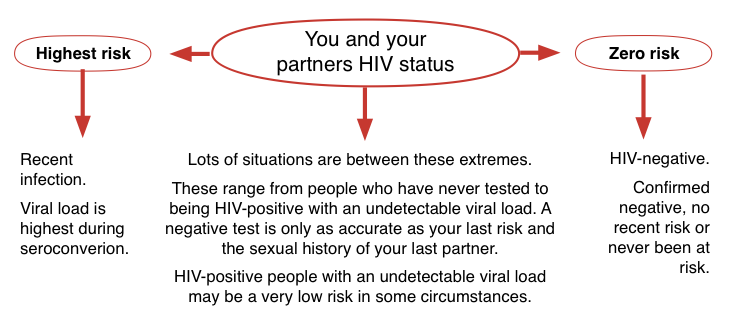HIV status of you and your partners
When both partners are negative
If both partners are HIV negative, then transmission cannot occur.
This involves knowing the current HIV status of both you and your partner. This is not the same as knowing their status last year, or the last time either of you tested.
Two partners having sex without a condom need to trust that neither partner could catch HIV outside the relationship. Or it is easy to use PrEP.
Monogamous relationships are not always monogamous all of the time.
When relationships change or breakdown other partners are often involved.
Sometimes it might be easier to continue using condoms than raise these issues of trust. Sometimes it is easier to use PrEP.
HIV negative people do not need to use condoms with each other if:
- They are both confirmed HIV negative and have no risks since.
- They had no risks in the three months before their last HIV test and no risks afterwards.
- There is no concern about pregnancy.
- There is no worry about STIs.
- They are using PrEP.
If you don’t know you or your partners HIV status
If you are negative and don’t know your partners status, it is always better to assume they are HIV positive.
If you don’t know your own HIV status, also assume you are HIV positive. This is so you don’t put anyone at risk.
Rather than assuming your partners are negative, this will stop you taking risks that you are not happy with.
This will help you feel in control during sex. It should stop you feeling anxious or worried afterwards.
Your HIV status is only as accurate as your last test result. This needs to include any risks you took in the window period before the test. It also needs to include any risks you have taken since.
 If one partner is positive and one is negative
If one partner is positive and one is negative
If one of you is HIV positive and one of you is HIV negative, you need to be careful to reduce the risk of transmission.
This involves learning about which activities have a risk and which are most safe.
If the HIV positive person has an undetectable viral load on ART then the risk is zero. It is zero even without condoms.
If the HIV negative person is taking PrEP then the risk of transmission is also zero. This is also zero without condoms.
PrEP is when HIV drugs are taken by an HIV negative person before and after sex to prevent HIV.
Condoms, if used correctly, protect against HIV.
Lots of couples where HIV status is different have full and active sex lives without the negative partner ever catching HIV.
See the sections in this guide on viral load, on condoms and on PrEP.
When both partners are positive: what about reinfection?
Many HIV positive people have sexual partners who are also positive.
If both partners are positive this removes the anxiety of worrying about HIV.
Knowing about reinfection is important. If either partner has drug resistance or a different type of resistance this can be transmitted.
How often reinfection occurs is not known. The risk is probably at least as low as catching HIV the first time. This will be higher if viral load is detectable and dramatically less for someone on effective treatment.
The implications for your health if reinfection occurs will depend on how serious the resistance is.
This means knowing about both your and your partners treatment history.
If neither of you have resistance, or if you both have the same resistance, then reinfection is not a problem.
But if one of you has drug resistance, and a detectable viral load, then reinfection would stop these drugs from working.
Last updated: 1 June 2021.

